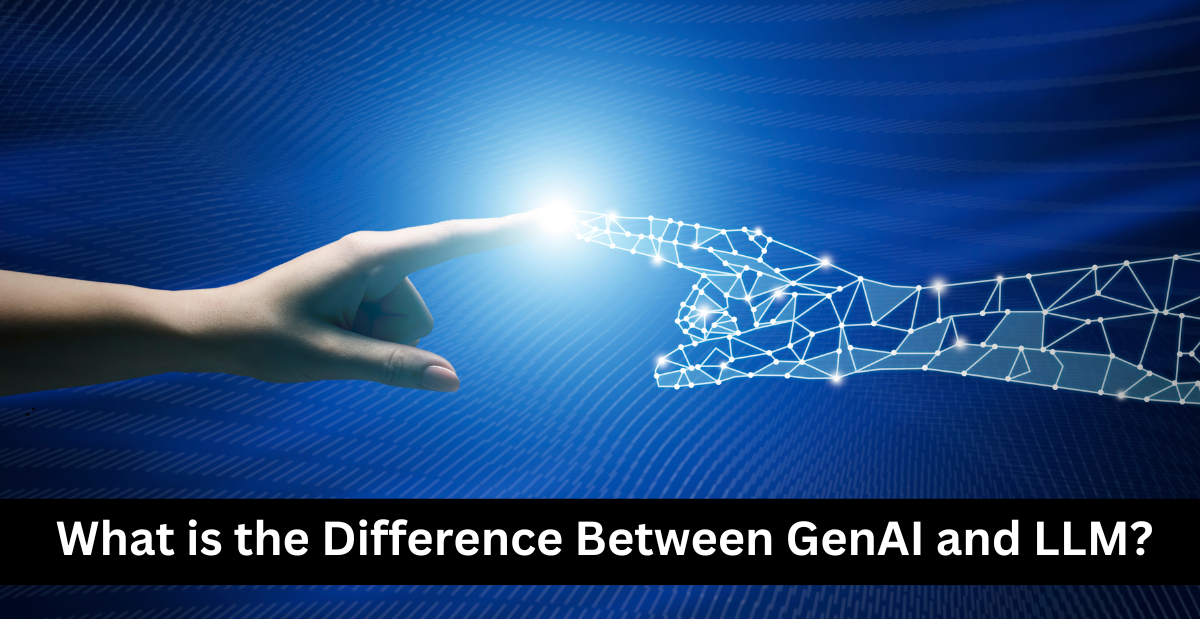What is the Difference Between GenAI and LLM?
What is the Difference Between GenAI and LLM?
Hello, reader! Artificial intelligence (AI) is becoming a buzzword in every corner of our lives, from chatbots answering our customer support queries to tools generating unique artworks and music. In this article, we’re diving deep into two of the most exciting developments in AI today: Generative AI (GenAI) and Large Language Models (LLMs). If you’ve ever wondered how they differ, what they do, and where they overlap, you’re in for an insightful journey.
First, Let’s Define the Stars of Our Show
Before diving into the nuances, it’s essential to understand what each term means.
- Generative AI (GenAI):
Generative AI refers to a category of artificial intelligence that focuses on creating new content. This content could be text, images, music, videos, or even code. Essentially, GenAI doesn’t just process or classify information—it produces something entirely new. For example:- Tools like DALL·E generate images based on text prompts.
- Models like ChatGPT create coherent and contextually relevant text, such as stories or emails.
- Large Language Models (LLMs):
LLMs, on the other hand, are a specific subset of AI models designed to understand and generate human-like text. They’re trained on vast datasets containing human language, allowing them to perform tasks like text completion, summarization, translation, and more. Think of them as the brain behind many GenAI applications focused on text.
The Core Difference: General vs. Specialized Capabilities
To put it simply, GenAI is a broad concept, while LLMs are one of its specialized tools. Let’s break this down further.
- Generative AI: The Big Picture
Imagine GenAI as an umbrella term. Under this umbrella, you’ll find various types of generative models designed for different kinds of outputs:- Text Generation: Handled primarily by LLMs like GPT or BERT.
- Image Generation: Managed by tools like DALL·E or Stable Diffusion.
- Audio/Music Generation: Powered by models like OpenAI’s Jukebox.
- Code Generation: Supported by systems like GitHub Copilot.
GenAI’s power lies in its versatility—it’s not restricted to text or any single medium.
- Large Language Models: A Specialized Subset
LLMs focus exclusively on text. They are designed to:- Predict the next word in a sequence (language modeling).
- Answer questions based on textual input.
- Summarize, translate, or even analyze sentiment in text.
While LLMs are incredible at working with language, they’re not equipped to generate images, music, or other non-textual content. They are one cog in the larger GenAI machine.
How Do They Work? The Tech Behind the Magic
Let’s geek out a bit and explore how GenAI and LLMs achieve their magic.
- Generative AI Workflow
Generative AI uses deep learning techniques to create new data. The core algorithms include:- GANs (Generative Adversarial Networks): Popular in image generation, GANs consist of two neural networks—the generator and the discriminator—that work in tandem to create realistic outputs.
- Transformers: These are the backbone of many GenAI applications, especially in text and image generation. They use attention mechanisms to focus on relevant parts of the input when generating new content.
- Variational Autoencoders (VAEs): Used for tasks like compressing data and generating images.
- Large Language Models’ Foundations
LLMs are a specific type of transformer model trained on vast amounts of text data. Here’s what makes them tick:- Pre-training and Fine-tuning: LLMs like GPT undergo two phases: pre-training on a general dataset (e.g., books, articles) to learn language patterns and fine-tuning on specific datasets for targeted tasks.
- Tokenization: They break down text into smaller units (tokens) to process language efficiently.
- Attention Mechanisms: LLMs pay attention to contextual relationships in the text to generate coherent and context-aware responses.
So, while both GenAI and LLMs rely heavily on transformers, their architectures and goals vary significantly.

Use Cases: Where GenAI and LLMs Shine
Here’s where the rubber meets the road. Let’s look at how these technologies are used in the real world.
- Generative AI in Action
GenAI can handle a diverse range of tasks:- Art and Design: AI tools like MidJourney and Stable Diffusion generate stunning visuals from textual descriptions.
- Content Creation: AI can write songs, scripts, or even marketing content.
- Simulation and Gaming: It creates realistic environments, characters, and narratives for immersive experiences.
- LLMs in Action
LLMs excel in text-based applications:- Customer Support: Chatbots like ChatGPT handle queries, complaints, and FAQs.
- Language Translation: Models like Google Translate use LLM technology for fast and accurate translations.
- Coding Assistance: Tools like GitHub Copilot suggest code snippets and debug issues.
While LLMs are part of the broader GenAI family, their text-focused nature makes them uniquely suited to tasks requiring nuanced language understanding.
Strengths and Limitations
Every technology has its pros and cons. Let’s explore these for both GenAI and LLMs.
- Generative AI
- Strengths:
- Versatility across various media types (text, images, audio, etc.).
- Useful for creative applications, such as storytelling and design.
- Limitations:
- Computationally expensive—requires powerful hardware and a lot of energy.
- Ethical concerns, such as deepfakes and misuse in misinformation campaigns.
- Strengths:
- Large Language Models
- Strengths:
- Exceptional in understanding and generating human-like text.
- Can perform multiple language-based tasks with a single model.
- Limitations:
- Struggle with factual consistency and may generate incorrect or biased information.
- Limited to text-based tasks, unlike GenAI, which spans multiple media types.
- Strengths:
Overlap Between GenAI and LLMs
If GenAI is the broader category, LLMs are its most prominent success story—at least for now. They overlap in:
- Language-Based Generative Tasks: For instance, generating poetry, stories, or essays is a shared capability.
- Creative Applications: LLMs are often integrated into larger GenAI systems to provide the “text” portion of multimedia outputs.
An example of this overlap is tools like ChatGPT, which use LLMs to generate textual content as part of a larger AI ecosystem.
What Lies Ahead? The Future of GenAI and LLMs
The AI landscape is evolving rapidly. Here’s what we might expect:
- For GenAI: More integration across different media types. For example, a single AI system might generate both the script and the accompanying visuals for a movie.
- For LLMs: Improved efficiency and accuracy, reducing issues like bias or factual errors.
Moreover, as AI systems grow more capable, the lines between GenAI and LLMs may blur further. We might not even distinguish between them in the future—they’ll simply be tools in the broader AI toolbox.

Summing It All Up
In summary, Generative AI (GenAI) and Large Language Models (LLMs) are two sides of the same coin. GenAI is the overarching concept encompassing all AI that creates, while LLMs specialize in language-related tasks. Both are shaping our world in fascinating ways, and their applications are virtually limitless.
Whether you’re an AI enthusiast, a tech professional, or just curious, understanding these differences can help you appreciate the revolutionary potential of these technologies. Who knows? The next groundbreaking GenAI tool or LLM might be something you create!
FAQs
1. What skills do I need to pursue a career in Generative AI or LLM development?
To build a career in Generative AI or LLMs, you need the following skills:
- Proficiency in programming languages like Python.
- Strong knowledge of machine learning and deep learning frameworks, such as TensorFlow or PyTorch.
- Understanding of natural language processing (NLP) concepts.
- Familiarity with transformer architectures like GPT and BERT.
- Knowledge of mathematics, especially linear algebra, probability, and statistics.
2. What types of roles are available in the field of Generative AI and LLMs?
Career roles in this field include:
- AI Research Scientist: Focuses on developing new algorithms and improving AI systems.
- Machine Learning Engineer: Designs and deploys AI models in production environments.
- Data Scientist: Analyzes and preprocesses data to train AI systems.
- NLP Engineer: Specializes in text-based models for tasks like translation, summarization, and chatbot development.
- AI Product Manager: Oversees the development and deployment of AI-powered products.
3. What industries are hiring professionals skilled in GenAI and LLMs?
The demand for AI professionals spans multiple industries, such as:
- Technology and Software Development
- Healthcare and Pharmaceuticals (e.g., AI-driven drug discovery)
- Finance (e.g., fraud detection, personalized recommendations)
- Media and Entertainment (e.g., content generation)
- E-commerce (e.g., recommendation systems)
- Education (e.g., AI tutors and personalized learning platforms)
4. How can I get started in the field of Generative AI and LLMs?
To begin:
- Learn the basics of AI, machine learning, and NLP through online courses or degree programs.
- Gain hands-on experience by working on projects, such as building chatbots or image generators.
- Explore pre-trained models like GPT, BERT, or Stable Diffusion to understand their workings.
- Participate in AI competitions on platforms like Kaggle.
- Build a strong portfolio showcasing your AI projects.
5. Do I need a degree to work in Generative AI or with LLMs?
While having a degree in computer science, data science, or a related field is advantageous, it is not mandatory. Many professionals enter this field by:
- Completing certifications and bootcamps.
- Showcasing projects on platforms like GitHub.
- Building a solid understanding of AI concepts through self-learning and practice.
6. What are the top companies hiring for Generative AI and LLM roles?
Leading companies in this field include:
- Tech Giants: Google (DeepMind), OpenAI, Microsoft, Meta, Amazon.
- AI Startups: Anthropic, Hugging Face, Cohere, Stability AI.
- Industry-Specific Firms: NVIDIA (hardware acceleration for AI), IBM (Watson AI), and healthcare companies leveraging AI.
7. Are there opportunities for non-technical roles in Generative AI and LLMs?
Yes, there are non-technical roles that play a crucial part in the success of AI systems, such as:
- AI Product Manager: Requires understanding AI capabilities and market needs.
- AI Ethics Specialist: Focuses on ensuring the ethical use of AI.
- AI Content Strategist: Develops content and communication strategies using AI tools.
- Business Analyst: Bridges the gap between AI development and business requirements.
8. What are some entry-level positions for newcomers in Generative AI?
Entry-level positions include:
- Machine Learning Intern
- Data Analyst
- Junior Data Scientist
- AI/ML Developer (Entry-Level)
- NLP Assistant Engineer
These roles provide hands-on experience and exposure to advanced AI projects.
9. What challenges can I expect in a career in Generative AI or LLMs?
Challenges include:
- Staying updated with rapid advancements in AI technologies.
- Managing large-scale datasets and computational resources.
- Addressing ethical concerns, such as bias and data privacy.
- Balancing the trade-offs between accuracy, interpretability, and efficiency in models.

Cybersecurity Architect | Cloud-Native Defense | AI/ML Security | DevSecOps
With over 23 years of experience in cybersecurity, I specialize in building resilient, zero-trust digital ecosystems across multi-cloud (AWS, Azure, GCP) and Kubernetes (EKS, AKS, GKE) environments. My journey began in network security—firewalls, IDS/IPS—and expanded into Linux/Windows hardening, IAM, and DevSecOps automation using Terraform, GitLab CI/CD, and policy-as-code tools like OPA and Checkov.
Today, my focus is on securing AI/ML adoption through MLSecOps, protecting models from adversarial attacks with tools like Robust Intelligence and Microsoft Counterfit. I integrate AISecOps for threat detection (Darktrace, Microsoft Security Copilot) and automate incident response with forensics-driven workflows (Elastic SIEM, TheHive).
Whether it’s hardening cloud-native stacks, embedding security into CI/CD pipelines, or safeguarding AI systems, I bridge the gap between security and innovation—ensuring defense scales with speed.
Let’s connect and discuss the future of secure, intelligent infrastructure.
